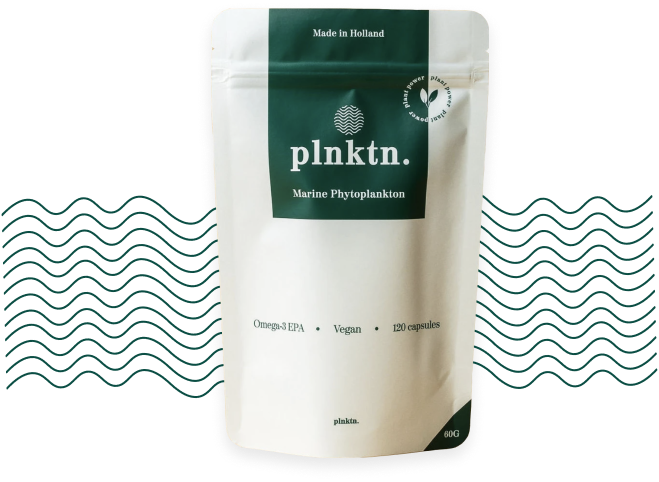Energy and Recovery
Energy and faster recovery
Marine phytoplankton consists of the smallest carriers of energy - nucleotides - and has minimal indigestible structures. As a result, the body does not need to process these nucleotides, but instead it can directly utilize its energy for biochemical reactions in the body.
You should feel effect within 20 minutes of taking it. The cells of Marine Phytoplankton are more narrow than those of Spirulina for example, making them more easy to digest.
Amino acids
Marine Phytoplankton, a natural source of amino acids
Marine phytoplankton contains all essential amino acids. When a protein is being digested it is broken down into amino acids. When you are physically active or when you are recovering, your body - and especially your muscles - use up their storage of amino acids (1).
Minerals: Iron, zinc, and magnesium
Marine Phytoplankton contains essential minerals that support performance (iron, zinc, and magnesium)
Marine Phytoplankton contains iron, zinc, magnesium, and many other minerals and trace elements. These essential minerals are incorporated into various proteins and enzymes, many of which influence physical endurance and performance (2).
Iron - plays a very important role in physical activity (3): it is an essential component of the two main proteins that transport and store oxygen in the body (hemoglobin and myoglobin). In general, women, athletes, and vegetarians exhibit the highest risk for an iron deficiency due to insufficient dietary iron and a caloric deficit (4).
Zinc - is responsible for the function of over 300 proteins and enzymes. Adequate amounts of zinc are necessary for muscle strength and endurance (5). Studies have shown that athletes have higher zinc required than people that are less active (6).
Magnesium - is responsible for adequate muscle function and plays a key role in the energy metabolism (7).

Nutrients that support physical performance
When we exercise, we put our body under stress. This is similar to when our body is dealing with other types of physical stress, such as inflammation. Physical exercise ramps up our metabolism, which increases the use of oxygen (8). At a later stage free oxygen radicals are produced in our body, which can damage our tissue. These radicals can cause oxidative stress which damage muscles, hamper their recovery and damage blood vessels.
Oxidative stress can cause decline in our physical performance and recovery (9).
The pigments from Marine Phytoplankton have anti-oxidative properties making them able to neutralize these free radicals. This will support your body to recover from the stress and physical toll of exercise or sports.
Marine Phytoplankton contains many anti-oxidants, such as astaxanthin: a pigment that has anti-oxidative properties 6000 times stronger than vitamine C (10-11).
It also contains beta-carotene, superoxide dismutase, and omega 3 fatty acids, and many other extremely powerful anti-oxidants (12).
Various research has shown that the antioxidant substances that are also present in Marine Phytoplankton can protect the body against exercise-induced damage to muscles (13, 14).

DISCOVER MARINE PHYTOPLANKTON
Marine Phytoplankton, an "all-in-one" superfood full of natural nutrients.
Besides being the source of Omega-3 fatty acids, Marine Phytoplankton is rich in vitamins minerals and strong antioxidants.
The perfect supplementation to your daily nutritional needs. Discover it now:
Please click below to see which scientific articles were used to gather information concerning the subject.
(1). Brooks GA. Amino acid and protein metabolism duringexercise and recovery. Med Sci Sports Exerc. 1987 Oct;19(5 Suppl):S150-6. PMID:3316914. https://pubmed.ncbi.nlm.nih.gov/3316914/
(2). McClung JP. Iron, Zinc, and Physical Performance. BiolTrace Elem Res. 2019 Mar;188(1):135-139. doi: 10.1007/s12011-018-1479-7. Epub 2018 Aug 15. PMID: 30112658.https://pubmed.ncbi.nlm.nih.gov/30112658/
(3). McClung JP, Murray-Kolb LE (2013) Iron nutrition andpremeno- pausal women: effects of poor iron status on physical and neuro-psychological performance. Annu Rev Nutr 33:271–288
(4). Beard, J & Tobin, B. (2000). Iron status& exericise. The American Journal of Clinical Nutrition, 72(2), 594-597. http://ajcn.nutrition.org/content/72/2/594s.full
(5). McClung, J.P.Iron, Zinc, and Physical Performance. Biol Trace Elem Res 188, 135–139 (2019).https://doi.org/10.1007/s12011-018-1479-7. https://link.springer.com/article/10.1007/s12011-018-1479-7
(6). Chu A, Holdaway C, Varma T, Petocz P, Samman S. LowerSerum Zinc Concentration Despite Higher Dietary Zinc Intake in Athletes: ASystematic Review and Meta-analysis. Sports Med. 2018 Feb;48(2):327-336. doi:10.1007/s40279-017-0818-8. PMID: 29164533. https://pubmed.ncbi.nlm.nih.gov/29164533/
(7). Zhang Y, Xun P, Wang R, Mao L, He K. Can MagnesiumEnhance Exercise Performance? Nutrients. 2017Aug 28;9(9):946. doi: 10.3390/nu9090946. PMID: 28846654; PMCID: PMC5622706.https://pubmed.ncbi.nlm.nih.gov/28846654/
(8). Nikolaidis MG, Jamurtas AZ. Blood as a reactivespecies generator and redox status regulator during exercise. Arch BiochemBiophys. 2009 Oct 15;490(2):77-84. doi: 10.1016/j.abb.2009.08.015. Epub 2009Aug 25. PMID: 19712664. https://pubmed.ncbi.nlm.nih.gov/19712664/
(9). Sakellariou GK, Jackson MJ, Vasilaki A. Redefining themajor contributors to superoxide production in contracting skeletal muscle. Therole of NAD(P)H oxidases. Free Radic Res. 2014 Jan;48(1):12-29. doi:10.3109/10715762.2013.830718. Epub 2013 Oct 7.PMID: 23915064. https://pubmed.ncbi.nlm.nih.gov/23915064/
(10). Kurashige M, Okimasu E, Inoue M, Utsumi K. Inhibitionof oxidative injury of biological membranes by astaxanthin. Physiol Chem PhysMed NMR. 1990;22(1):27-38. PMID: 2084711. https://pubmed.ncbi.nlm.nih.gov/2084711/
(11). Goto S, Kogure K, Abe K, Kimata Y, Kitahama K,Yamashita E, Terada H. Efficient radical trapping at the surface and inside thephospholipid membrane is responsible for highly potent antiperoxidativeactivity of the carotenoid astaxanthin. Biochim Biophys Acta. 2001 Jun6;1512(2):251-8. doi: 10.1016/s0005-2736(01)00326-1. PMID: 11406102. https://pubmed.ncbi.nlm.nih.gov/11406102/
(12). Branco R, Morais PV. Two superoxide dismutases fromTnOtchr are involved in detoxification of reactive oxygen species induced bychromate. BMC Microbiol. 2016;16:27. Published 2016 Mar 5.doi:10.1186/s12866-016-0648-0. https://www.ncbi.nlm.nih.gov/pmc/articles/PMC4779226/
(13). Bryer SC, Goldfarb AH. Effect of high dose vitamin Csupplementation on muscle soreness, damage, function, and oxidative stress toeccentric exercise. Int J Sport NutrExerc Metab. 2006 Jun;16(3):270-80. doi: 10.1123/ijsnem.16.3.270. PMID:16948483. https://pubmed.ncbi.nlm.nih.gov/16948483/
(14). Silva LA, Pinho CA, Silveira PC, Tuon T, De Souza CT,Dal-Pizzol F, Pinho RA. Vitamin E supplementation decreases muscular andoxidative damage but not inflammatory response induced by eccentriccontraction. J Physiol Sci. 2010 Jan;60(1):51-7. doi:10.1007/s12576-009-0065-3. Epub 2009 Oct 27. PMID: 19859781. https://pubmed.ncbi.nlm.nih.gov/19859781/
